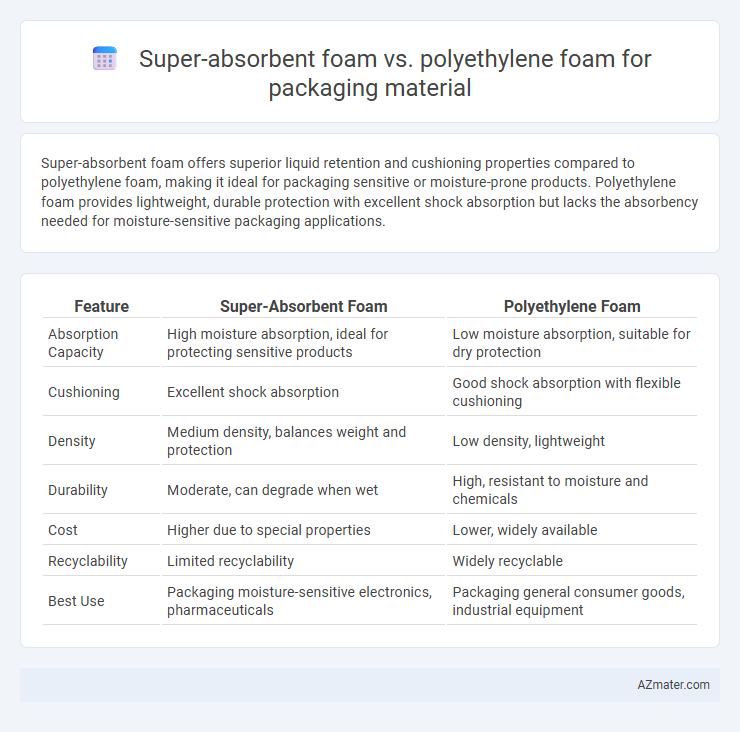Super-absorbent foam offers superior liquid retention and cushioning properties compared to polyethylene foam, making it ideal for packaging sensitive or moisture-prone products. Polyethylene foam provides lightweight, durable protection with excellent shock absorption but lacks the absorbency needed for moisture-sensitive packaging applications.
Table of Comparison
| Feature | Super-Absorbent Foam | Polyethylene Foam |
|---|---|---|
| Absorption Capacity | High moisture absorption, ideal for protecting sensitive products | Low moisture absorption, suitable for dry protection |
| Cushioning | Excellent shock absorption | Good shock absorption with flexible cushioning |
| Density | Medium density, balances weight and protection | Low density, lightweight |
| Durability | Moderate, can degrade when wet | High, resistant to moisture and chemicals |
| Cost | Higher due to special properties | Lower, widely available |
| Recyclability | Limited recyclability | Widely recyclable |
| Best Use | Packaging moisture-sensitive electronics, pharmaceuticals | Packaging general consumer goods, industrial equipment |
Introduction to Packaging Foams
Super-absorbent foam excels in packaging applications requiring moisture management, offering superior liquid retention and protection for sensitive products. Polyethylene foam provides lightweight, shock-absorbing cushioning with excellent resilience and chemical resistance, making it ideal for general impact protection during shipping. Both materials enhance product safety, yet selection depends on specific packaging needs such as moisture control versus mechanical cushioning.
What is Super-Absorbent Foam?
Super-absorbent foam is a highly porous material designed to absorb and retain large volumes of liquid relative to its mass, making it ideal for packaging sensitive or moisture-prone items. Its structure enables rapid liquid uptake, providing effective cushioning while preventing damage from spills or humidity. Unlike polyethylene foam, which primarily offers shock absorption and insulation, super-absorbent foam combines liquid retention with protective cushioning in packaging applications.
What is Polyethylene Foam?
Polyethylene foam is a closed-cell, lightweight, and durable packaging material known for its excellent shock absorption and cushioning properties. It resists moisture, chemicals, and temperature variations, making it ideal for protecting sensitive items during shipping and storage. Compared to super-absorbent foam, polyethylene foam offers superior resilience and long-term performance in packaging applications.
Key Physical Properties Comparison
Super-absorbent foam exhibits superior moisture retention and cushioning efficiency compared to polyethylene foam, making it ideal for packaging sensitive items requiring protection from humidity and impact. Polyethylene foam offers greater resilience, lightweight flexibility, and chemical resistance, ensuring durability under various environmental conditions. Key physical properties such as density, compressive strength, and water absorption rate distinctly favor polyethylene foam for structural support, whereas super-absorbent foam excels in liquid containment and pressure distribution.
Absorption Capabilities: Foam vs Foam
Super-absorbent foam exhibits superior liquid absorption capabilities, typically absorbing up to 500 times its weight, making it ideal for packaging moisture-sensitive products. Polyethylene foam primarily offers cushioning and impact resistance with minimal liquid absorption, absorbing only trace amounts of moisture. The high absorption rate of super-absorbent foam significantly reduces the risk of damage caused by moisture compared to the low-absorbing polyethylene foam.
Cushioning Performance and Shock Protection
Super-absorbent foam offers superior cushioning performance due to its ability to absorb and distribute impact energy effectively, making it ideal for delicate or high-value items requiring enhanced shock protection. Polyethylene foam provides reliable cushioning with excellent resilience and closed-cell structure that resists moisture and compression, suitable for general packaging needs where moderate impact protection is sufficient. The choice depends on specific application demands, with super-absorbent foam excelling in high-impact scenarios and polyethylene foam favored for lightweight, moisture-resistant packaging solutions.
Moisture Resistance and Water Management
Super-absorbent foam outperforms polyethylene foam in moisture resistance by absorbing and retaining large amounts of water, effectively preventing moisture damage in sensitive packaging. Polyethylene foam, while providing a waterproof barrier, lacks the capacity to absorb and manage moisture internally, making it less effective for protecting products exposed to high humidity or liquid spills. Choosing super-absorbent foam enhances water management in packaging by minimizing condensation and maintaining a dry microenvironment around the contents.
Cost Analysis of Packaging Alternatives
Super-absorbent foam generally incurs higher initial costs compared to polyethylene foam due to advanced chemical formulations and superior absorbency properties. Polyethylene foam offers a cost-effective solution with lower manufacturing expenses, making it suitable for bulk packaging where moisture control is less critical. Selecting between these materials depends on packaging requirements, with super-absorbent foam ideal for sensitive goods needing moisture absorption despite the premium price.
Environmental Impact and Sustainability
Super-absorbent foam offers biodegradability and reduced environmental footprint compared to traditional polyethylene foam, which is derived from non-renewable petrochemicals and poses significant recycling challenges. Polyethylene foam's persistence in landfills and contribution to microplastic pollution contrast with super-absorbent foam's potential for compostability and improved waste management. Selecting super-absorbent foam enhances packaging sustainability by minimizing long-term ecological damage and supporting circular economy principles.
Choosing the Right Foam for Your Packaging Needs
Super-absorbent foam offers exceptional moisture absorption, making it ideal for packaging sensitive electronics or medical products that require protection from liquid damage. Polyethylene foam provides superior cushioning and shock absorption, suitable for heavier or fragile items during shipping. Choose based on the product's vulnerability to moisture, weight, and impact sensitivity to ensure optimal protection and cost-efficiency.

Infographic: Super-absorbent foam vs Polyethylene foam for Packaging material
 azmater.com
azmater.com